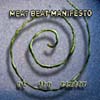 When I was in high school, my friends and I used to have thisdiscussion all the time about how Jack Dangers had such a signaturesound that he could take anyone else's song and remix it into somethingthat was unmistakably Meat Beat Manifesto. It shouldn't come as anysurprise then that some fifteen years later when Dangers has taken onthe task of producing a jazz record for Thirsty Ear, that the result still sounds like quintessential Meat Beat.
When I was in high school, my friends and I used to have thisdiscussion all the time about how Jack Dangers had such a signaturesound that he could take anyone else's song and remix it into somethingthat was unmistakably Meat Beat Manifesto. It shouldn't come as anysurprise then that some fifteen years later when Dangers has taken onthe task of producing a jazz record for Thirsty Ear, that the result still sounds like quintessential Meat Beat.Thirsty Ear
While jazz sampling and experimentation are nothing new to the MeatBeat catalog, this is the first record in a long and noteworthy careerthat is explicitly anchored more in the jazz tradition than in theworld of club music, hip hop, and dub. I should note that I don'tlisten to much jazz: I know what I like and numerous attempts to getinto jazz have just left me to conclude that the genre as a whole isnot really my cup of tea. However, a record like At The Centerexists to change that. Thirsty Ear has been building a catalog thatcould be described as "jazz for people who don't like jazz" by courtingpeople from the electronic music world and getting them to participatein 'The Blue Series.' Records from DJ Spooky, DJ Wally, Spring HeelJack and others have all found their way into my record collection asambassadors to a sound and style and tradition that I don't usuallyembrace. Of the Blue Series records I've heard, At The Centeris perhaps the one that manages to keep the most of its creator'soriginal identity in place while staying faithful to the intention ofthe project. This record is comprised of wiggly flute and clarinetpieces, upright bass, shuffling drum beats, playful stabs of piano, andodd samples—the usual. The sounds themselves aren't particularly newfor a Meat Beat release, but they are cleaner and less processed thanusual, giving the record much more of an improvised and live feel. Onlyone track is longer than six minutes, and that's perhaps the greatestsuccess for this record: that it manages to explore and stretch withoutgetting self-indulgent the way some jazz does. That's not to say therecord is made up completely of gems. There are two tracks with anextended recording of someone reading quirky want ads in a strangevoice, and while the tracks were funny the first or second time I heardthem, they drag on after many more listens. However, astute listenerswill hear some faint recycling of jazz touches and melodic phrases fromolder Meat Beat records worked into the fray and that kind ofself-sampling even when the instruments are being played live is sonecessarily Meat Beat Manifesto that the record ultimately breezes pastany low points. At The Center makes genre and style irrelevantto the equation of enjoying music, and that's what it's all about inthe end. Like many other talented multi-instrumentalists and composers,the result of the work is less about songs that fulfill a stylisticpromise and more about their creator's will imposing itself regardlessof the format, rules, or expectations. That Dangers is backed by atalented gang of players only makes the disc that much more of asuccess.
samples:
Read More

